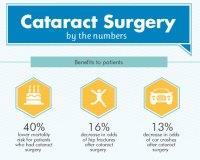Author-Skinner Velazquez
When contemplating the option between typical cataract surgery and laser-assisted techniques, you might find yourself evaluating the advantages and disadvantages each method provides. The choice exceeds the surface area degree of cost and precision, delving right into the world of long-term results and individual contentment. As you navigate via the intricacies of these two techniques, it ends up being imperative to understand the nuanced details that can considerably impact your aesthetic quality and general experience. Keep tuned to discover the essential aspects that will lead your decision-making process in this essential aspect of eye treatment.
Typical Cataract Surgery Pros and Cons
When taking into consideration traditional cataract surgical treatment, you may find that it's a well-established and widely-used strategy. In this procedure, a specialist makes a little incision in the eye and uses ultrasound to break up the gloomy lens before removing it. When the cataract is gotten rid of, a synthetic lens is placed to recover clear vision.
Among the primary benefits of conventional cataract surgery is its performance history of success. Several individuals have actually had their vision considerably boosted via this treatment. Furthermore, standard surgical treatment is frequently covered by insurance policy, making it an extra accessible choice for numerous individuals.
However, there are some downsides to standard cataract surgery also. Healing time can be much longer contrasted to newer strategies, and there's a somewhat greater danger of difficulties such as infection or swelling. Some individuals may likewise experience astigmatism or call for reading glasses post-surgery.
Laser-Assisted Techniques Advantages And Disadvantages
Exploring laser-assisted methods for cataract surgery unveils a modern technique that utilizes laser technology to perform essential action in the treatment. Among the primary advantages of laser-assisted cataract surgery is its precision. The laser allows for extremely accurate lacerations, which can result in better aesthetic outcomes. Furthermore, the use of lasers can decrease the quantity of ultrasound power needed throughout the surgical procedure, potentially lowering the threat of complications such as corneal damage.
On the disadvantage, laser-assisted techniques can be much more expensive compared to typical approaches. This expense mightn't be covered by insurance, making it less available to some clients.
Nidek is that not all cataract doctors are trained in laser technology, which could restrict your choices for picking a surgeon.
Finally, while the laser can automate certain facets of the procedure, the surgery still calls for a skilled surgeon to make sure effective results.
Comparative Evaluation of Both Approaches
For a comprehensive understanding of cataract surgery methods, it's important to conduct a comparative analysis of both traditional and laser-assisted techniques.
Traditional cataract surgery involves hands-on incisions and making use of handheld tools to separate and remove the gloomy lens.
On the other hand, laser-assisted cataract surgical treatment uses innovative innovation to develop specific lacerations and separate the cataract with laser power prior to removing it.
In regards to precision, laser-assisted strategies use a higher degree of precision compared to standard techniques. The use of lasers permits modification of the procedure based upon each patient's eye makeup, possibly causing much better visual results.
Nevertheless, laser-assisted cataract surgical treatment tends to be extra costly than typical surgical treatment, which may limit accessibility for some patients.
While Uncorrected Visual Acuity work in bring back vision damaged by cataracts, the option in between typical and laser-assisted strategies commonly depends on aspects such as price, precision, and private patient demands.
Consulting with your ophthalmologist can help establish the most ideal technique for your cataract surgery.
Conclusion
In conclusion, when determining in between traditional cataract surgical treatment and laser-assisted strategies, think about aspects like expense, precision, and private demands. Traditional surgical procedure provides a proven performance history and insurance policy protection but might include longer recovery times. Laser-assisted strategies supply greater precision and modification however can be much more pricey and not always covered by insurance. Inevitably, the selection in between both methods depends upon what is essential to you and your particular situation.

